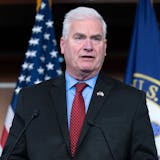In America's halting march toward racial equality, the 1960s of lunch-counter sit-ins and Martin Luther King's nonviolence movement occupy much of the nation's historic consciousness. Yet in "Red Summer," author Cameron McWhirter argues that four decades before peaceful protests there was violent resistance: specifically, five months of racial bloodshed in 1919 that forged African-American self-determination and galvanized the nation's oldest civil rights organization into a force that changed history.
McWhirter weaves an understated, powerful narrative about a season in which scores of blacks and many whites met senseless, grisly deaths in killing fields that stretched from backwoods Georgia to Chicago's dense, hardscrabble South Side. The horror -- mob violence instigated by whites and African-Americans' decision to fight back -- spurred civil rights pioneer W.E.B. Du Bois and others in the newly formed National Association for the Advancement of Colored People to act, developing their political clout in the process.
In unflinching, just-the-facts style bolstered with copious footnotes, McWhirter describes how the entrenched white power structure -- small-town police, elected officials, businessmen and even newspapers -- were bent on preserving the social order in uncertain economic times. But African-Americans, some of whom had fought with valor in World War I, were chafing under Jim Crow rule and discrimination in the open marketplace.
While racist authorities downplayed white-on-black violence, McWhirter writes, anxiety about black restlessness and threats to the status quo led them to play up inflammatory, dubious allegations of black-on-white crime, stoking already heightened fear. Angry lynch mobs, sometimes fueled by alcohol and rumors, armed themselves, strung up black suspects and then headed to black neighborhoods to further satisfy the bloodlust. White power brokers usually turned a blind eye to the violence or failed to crack down until the bodies began to pile up.
Even President Woodrow Wilson -- who, McWhirter notes, sent eager black troops to fight in World War I in the name of democracy and lobbied postwar Europe to create the League of Nations (a precursor to the United Nations) -- failed to intercede either nationally or locally, allowing a deadly race riot to rage just blocks from the White House.
On the streets, however, African-Americans didn't wait for help that wasn't coming.
While overmatched, blacks used deadly force to defend their neighborhoods, some with experience gained on European battlegrounds. Meanwhile, the NAACP's campaign to stop the carnage, McWhirter writes, helped propel the organization and Du Bois to national prominence, emboldened ordinary black people -- farmers, teachers, small businessmen -- to fight for equality, and set the battlefield for future generations.
The crucible of 1919 created "a new dynamic in race relations," McWhirter writes. Blacks broadly challenged "the long-held premise that they exist in this country as inferiors. Led by the NAACP and other groups, they began to assert themselves as equals -- many for the first time in their lives."

